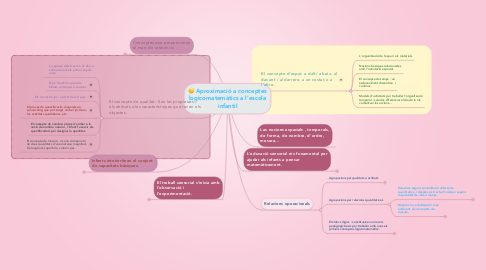
1. Conceptes que proporcionen el marc de referència .
1.1. Numbers, budget, waterfall, break-even (cost>leads>trials>deals)
1.2. Sales Programs
1.3. Accelerated Learning Strategy, Controls, Metrics
1.4. Include feedback loops
1.5. Include financial metrics (definition of success)
1.6. Pipeline reports, etc…
2. Infants interioritzen el conjunt de capacitats bàsiques.
2.1. Positioning & Messaging
2.1.1. What is the key messaging and positioning for the service offer? (Pain, alternatives, solution)
2.1.2. How do we communicate internally?
2.1.3. How do we communicate externally?
2.2. Promotion Strategy
2.2.1. Marketing Programs (Installed base versus new prospects)
2.2.2. Advertising (Publications, etc.)
2.2.3. Analyst Relations (Target Analysts)
2.2.4. Public Relations
2.2.5. Events (Trade shows, SEO/SEA, Seminars)
2.2.6. Webinars
2.3. Demand Generation & Lead Qualification
2.3.1. How do we generate and qualify new leads for the target offer?
2.3.2. Prospect Lists
2.3.3. Key Questions to Ask
2.3.4. Sales Collateral
2.3.5. Presentations
2.3.6. Data Sheets
2.3.7. White Papers
2.3.8. ROI Tools
2.3.9. Other Sales Tools (web site, etc.)
3. El treball sensorial s'inicia amb l'observació i l'experimentació.
3.1. Revenue Forecasts
3.1.1. Revenue and P&L Forecast (5 Years)
3.1.2. Revenue should be split out quarterly
3.2. Cost Analysis
3.2.1. Should include a description of the costs in entering this business and profitability analysis
3.3. Profitability Analysis
3.3.1. P&L for the offer to include gross margin, net income and break even analysis.
4. El concepte de qualitat : Són les propietats , els atributs o les característiques que tenen els objectes.
4.1. La panera dels tresors: es duu a terme durant els primer any de vida.
4.1.1. This document describes our Go To Market Plan for <Product Name>.
4.2. El joc heurístic: quan els infants començen a caminar.
4.3. Els racons de joc: a partir dels 2 anys.
4.4. El procés de quantificació: requereis un procés llarg que pot sorgir amb el joc lliure, les activitats quotidianes ,etc.
4.4.1. ue
4.5. El concepte de nombre: abans d'arribar a la noció de nombre natural , l'infant fa servir els quantificadors per designar la quantitat.
4.6. El concepte de mesura: és una comparació de dues quantitats d'una mateixa magnitud. De longitud, superfície, volum i pes.
4.6.1. Training
4.6.2. Channels
4.6.3. International
4.6.4. Public Sector
4.6.5. Sales
4.6.6. Marketing Communications
4.6.7. Product Management
5. L'educació sensorial eix fonamental per ajudar als infants a pensar matemàticament.
5.1. Sales Strategy
5.1.1. Direct Sales Strategy
5.1.2. Inside Sales Strategy
5.1.3. Channel Sales Strategy
5.2. Partner Strategy
5.2.1. Channel Strategy
5.2.1.1. What 3rd party channels should we consider for reselling this service?
5.2.2. Technology Partnerships
5.2.2.1. What technology vendors (if any) do we need to work with to execute on this plan?
5.2.3. Solutions Partners
6. Les nocions espacials , temporals, de forma, de nombre, d'ordre, mesura...
7. El concepte d'espai: a dalt/ a baix, al davant / al darrere, a un costat o a l'altre.
7.1. L'organització de l'espai i els materials
7.2. Nocions bàsiques relacionades amb l'orientació espacial.
7.3. El concepte de temps : un esdeveniment discontinu i continus.
7.4. Models d'activitats per treballar l'organització temporal : saludar, diferenciar el dia de la nit, verbalitzar les accions...
8. Relacions operacionals
8.1. Agrupacions per qualitats o atributs
8.1.1. Situational Analysis / Drivers
8.1.1.1. What is driving us to do this?
8.1.1.2. SWOT Analysis
8.1.1.2.1. Strengths
8.1.1.2.2. Weaknesses
8.1.1.2.3. Opportunities
8.1.1.2.4. Threats
8.1.1.3. Customer Findings - What have we learned from customers?
8.1.2. Competitive Analysis
8.1.2.1. Do we have competitors and threats in these target markets with the proposed offerings?
8.1.2.2. What are our competitors doing and how are they positioning?
8.1.2.3. How do we position against each competitor?
8.1.3. Target Customer(s)
8.1.3.1. Buyer Profile
8.1.3.1.1. Title
8.1.3.1.2. Industry
8.1.3.1.3. Geography
8.1.3.1.4. Business Size
8.1.3.2. Influencer Profile
8.1.3.3. User Profile
8.1.3.4. What do customers want and need?
8.1.3.5. What business problems do each of these customers have?
8.1.4. Customer Segmentation
8.1.4.1. Which customers or sets of customers do we sell to?
8.1.4.2. What are the target market segments that we want to go after?
8.1.4.3. What are the distinct problems for each segment of the market?
8.1.5. Total Available Market
8.1.5.1. New Prospects
8.1.5.1.1. How much of each target segment have we penetrated?
8.1.5.1.2. How much opportunity is available in each target segment?
8.1.5.2. Existing Customers
8.1.5.2.1. Can we up-sell existing customers?
8.2. Agrupacions per relacions quantitatives
8.2.1. Relacions segons la similitud o diferència quantitativa i desprès es tracta d'ordenar segons la quantitat de més a menys .
8.2.1.1. What are we selling?
8.2.1.2. Product Definition
8.2.1.3. Pricing
8.2.1.4. Packaging
8.2.1.5. Positioning
8.2.2. Desprès la verbalització i més endevant els conceptes de mesura.
8.2.2.1. What is the Value Proposition to the Customer?
8.2.2.2. What pain are we solving?
8.3. Els blocs lògics : constitueixen un recurs pedagògic bàsic per treballar amb nens els primers conceptes logicomatemàtics.
8.3.1. M&A?
8.3.2. Risk Analysis & Mitigation
